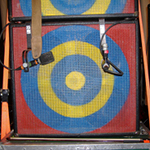Cordy Ryman
Shuffle/Scrap/Echo
Visual Arts Center of New Jersey
68 Elm Street, Summit, NJ
January 11–March 24, 2013
A highly pleasurable aspect of Cordy Ryman’s work is that just by looking at it, you can see how each piece was made. Humble and unpretentious, the twelve handmade, wall-mounted wooden objects in Shuffle/Scrap/Echo are fashioned from materials common to construction sites or a carpenter’s shop: lumber, sawdust, and acrylic and enamel paint, but also epoxy resin, urethane foam, and Velcro. Using neither tricks nor gimmicks when covering things with paint and gluing them together, Ryman tenders an art that is honest rather than factual, injecting a stale formalism with new life though a playful, idiosyncratic approach.
One large work, Wave Echo Scrap Ghost (2012), comprises four squares with dozens of small cut two-by-fours—seemingly the odds and ends that were tossed aside—affixed to backing plywood. Ryman haphazardly arranges the topography of each quadrant, with the assorted brick-sized chunks at bottom right daubed with pale lavenders and creamy aqua, and those at top left in shades of green, with the facing surfaces of most blocks slathered in white paint. Another quarter at upper right incorporates predominantly wedges with the natural color of processed wood, and the fourth section pops with primary colors.
Ryman assembled Wave Echo Scrap Ghost from the leftovers of previously exhibited installations, so he’s recycling his own, presumably unsold work. He similarly reconfigured Windowboxing (2010/13) alongside a long wall, stacking several dozen rectangular frames built with two-by-fours in a jumbled triangular formation that nearly reaches the ceiling. The front edges and exterior sides of these frames are painted white, matching the drywall behind them, but the interior edges are coated with iridescent orange, pink, fuchsia, and yellow, along with sunflower, red, and blue. Unlike the previous installation, a vertical column that is part of the room’s architecture bisects Windowboxing, emphasizing how the artist can fluently adapt an older work to a new situation.
The physical properties of materials, processes of construction, and sites of display: these undeniably interest Ryman. But if his subject matter is unclear—if he has any at all—the works are satisfying nonetheless. There’s a certain joy in the way the distressed irregular slats surround a hot-pink center in Trim Core (2012), or how the white, yellow, and blue sawdust circles in Coil Sweeping (2012) radiate outward from an ovoid glob of milky paint. Free of the puritanical dogma and theoretical concerns commonly associated with formalism, Ryman’s work is casual, carefree, and fun.
Originally published in Modern Painters in May 2013.
